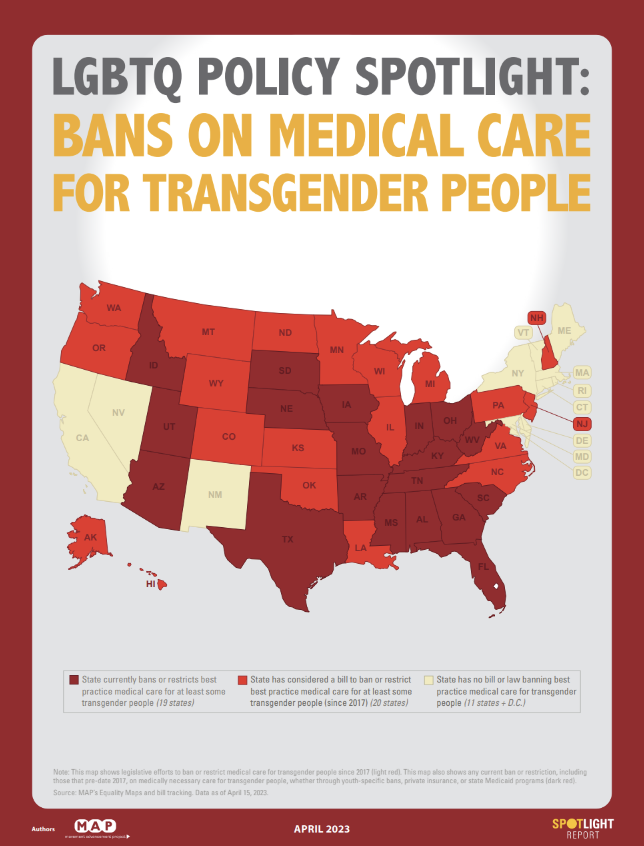Policy Spotlight: Bans on Medical Care for Transgender PeopleDownload Equality Map: Healthcare Laws and PoliciesLearn More Equality Map: Bans on Medical Care for Transgender YouthLearn More Equality Map: Medicaid Coverage of Transgender-Related Health CareLearn More
Please note: the report includes updates as of April 15, 2023. Due to this quickly changing political landscape, please refer to our Equality Maps, which are updated in real time.(Update, April 20, 2023: shortly after this report was launched, North Dakota enacted a ban on medical care for transgender youth. 16 states currently ban or restrict best-practice medical care for transgender youth. View our real-time Equality Map here.)LGBTQ Policy Spotlight: Bans on Medical Care for Transgender People provides the most comprehensive look to date at the sweeping attempts to ban and restrict medical care for not only transgender youth—but also transgender adults. MAP analyzed the more than 250 bills introduced in recent years that attack access to medical care for transgender people. In this detailed analysis, MAP illustrates the extent of how recent bills targeting medically necessary care for transgender people are expanding and becoming more extreme. Prior to 2021, no states banned medical care for transgender youth, but now 15 states have bans on at least some forms of medical care, and many more states are actively pursuing similar bans. As a result, nearly one in five (19%) transgender youth currently live in states where they are banned from receiving best-practice medical care, in addition to transgender adults living in Missouri. Snapshot of legislative attempts in 2023 and recent years to block medically necessary care for transgender people:
- Just three months into 2023, more bills attacking access to health care for transgender people have been introduced than in the last six years combined.
- Nearly three in 10 bills (29%) introduced in 2023 would ban or restrict care for both transgender children and transgender adults.
- Nearly half of bills this year would prevent state funding for medical care for at least some transgender people, such as through state employee health plans and Medicaid.
- Since 2020, roughly one out of seven bills (14%) would ban or restrict private insurance companies from covering or reimbursing the costs of best-practice medical care for transgender people, or would explicitly allow insurance companies to refuse coverage outright.
- The number of bills that make it easier for people to sue doctors who provide medical care to transgender people nearly quadrupled from 16% in 2020 to 61% in 2023.
Snapshot of the broader policy landscape: The health care targeted by anti-transgender extremists is medically necessary care that is prescribed by experienced doctors who utilize best practices that are endorsed by all major medical groups, including the American Academy of Pediatrics and the American Medical Association. * Please note: the report includes updates as of April 15, 2023. Due to this quickly changing political landscape, please refer to our Equality Maps, which are updated in real time.
Recommended citation format:
Movement Advancement Project. April 2023.
LGBTQ Policy Spotlight: Bans on Medical Care for Transgender People. https://www.mapresearch.org/2023-medical-care-bans-report.


